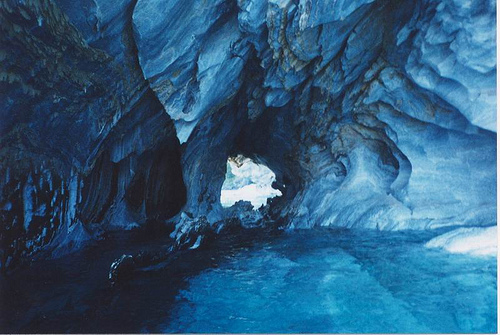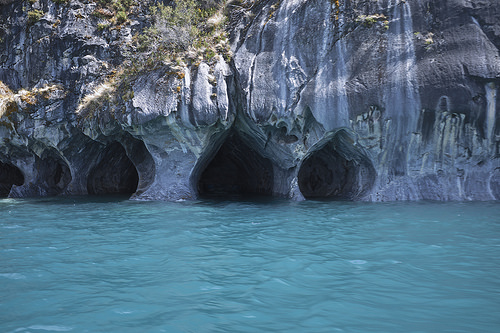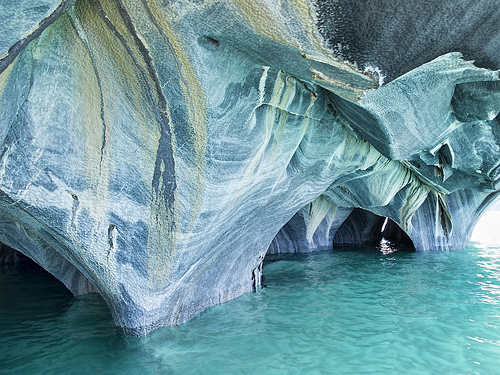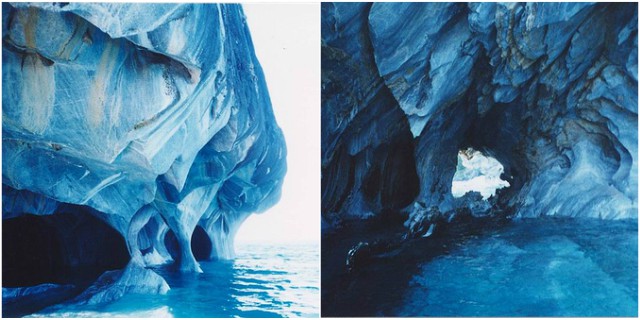Sea caves, natural formations created by wind and water slowly eroding shore cliffs, are found all around the world. Many are geographical anomalies, featuring a unique convergence of natural elements.
One of these formations is known as the Marble Caves. The Marble Caverns are three different structures: the Cave, the Chapel, and an intricate system of water-filled caverns called the Marble Cathedral.
The Marble Caves are mineral formations made of calcium carbonate located in the General Carrera Lake, Chile, just a few miles from the small village of Puerto Tranquilo.

The incredible underground caves made entirely of marble are among the most beautiful and spectacular caves on our planet.
They have been formed by flowing water over 6,000 years and are one of nature’s greatest miracles. Their beautiful color is due to a reflection of the lake’s azure waters.
The General Carrera Lake spans the Chile-Argentina border, and it’s one of the ten deepest lakes in the world with a maximum depth of 586 meters.
The lake was discovered by the Argentinian geographer Carlos Moyano during an exploration journey in 1880. He was the one who gave the lake the name Buenos Aires. In Chile in 1959, coinciding with a new political and administrative division of the Aysen province, the lake was given the name of General Carrera, to honor one of the main heroes of the country’s independence.
The Marble Caves are hidden from view from the coast and they are located approximately in the middle of the lake on the Chilean side.

The chapels were declared “Nature’s Sanctuary, ”one of the protection categories considered on the Chilean legislation on National Monuments. Despite this, they are still not well know outside the area and almost unknown to international tourism.
For thousands of years, the water, and the wind have battered the rock unveiling the marble and limestone components, calcium carbonate, quartz, and limonite.
The Italian-Argentinian explorer Clemente Onelli documented the existence of the chapels in his book Climbing the Andes, where he related his 1896-1897 journey, sponsored by the Argentinian government as part of the exploration and reconnaissance campaigns led by the borders expert Francisco P. Moreno.

Sadly, Lake Carrera is under threat from development. Chile plans to build five hydropower dams in Patagonia. Of course, this is going to disrupt the habitats of many unique and endangered species in the area as well as potentially disturb the beautiful lakes, including Lake Carrera.
To get to the caves, one must embark on a long and difficult journey starting from a flight to the Chilean capital of Santiago. Visitors must then travel 800 miles on major highways to the next big city Coyhaique, followed by a 200-mile drive on rough dirt roads towards the lake.
Finally, a boat is needed to access the caves. But though the journey is long and challenging, many agree the enchanting beauty of the caves is definitely worth the effort.

The Rivers Baker and Pascua that are the major water sources to the lake are under threat from the imminent construction of hydroelectric dams.
The need for new sources of electricity does not cease to be a grave problem facing the Chilean government, however, and hydroelectric power continues to be a viable option.
This could possibly involve the installation of high-tension power lines above the very caves themselves, and the flooding of part of the river valleys, to the potential detriment of this pristine paradise of zen and breath-taking natural beauty.
